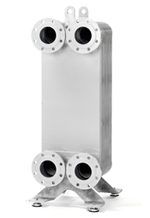A key component in waste heat recovery is the heat exchanger. The profitability of an investment in waste heat recovery depends heavily on the efficiency of heat exchangers and their associated life cycle costs (purchase, maintenance, etc).
All these factors vary considerably between different heat exchanger technologies. Although compact heat exchangers are very common in the process industry today, shell-and-tube heat exchangers are still dominating.
Compact heat exchangers have many benefits over shell-and-tubes:
The choice of heat exchanger is very important and has a direct impact on the bottom-line result. In fact, replacing old shell-and-tubes with new compact heat exchangers in existing heat recovery systems is often a very good investment, thanks to the strong benefits.
 In 2011, Alfa Laval compared the heat recovery per invested dollar of an AlfaNova compact heat exchanger with that of a BEM type shell-and-tube with stainless steel tubes and stainless-steel-cladded tube sheets.
In 2011, Alfa Laval compared the heat recovery per invested dollar of an AlfaNova compact heat exchanger with that of a BEM type shell-and-tube with stainless steel tubes and stainless-steel-cladded tube sheets.
The initial values for the simulation were specifications from an existing condensate-stripper-tower interchanger. The temperature approach was gradually decreased in the simulation and the maximum amount of transferable heat between the two streams was indicated.
The results show that the yield from the AlfaNova is up to 25% higher than for the shell-and-tube at a comparable cost, cf. the diagram. To reach the same levels of heat recovery the shell-and-tube becomes several times more expensive.
Compact heat exchangers are up to five times more efficient than shell-and-tubes, making heat recovery profitable even where the energy sources traditionally have been deemed worthless.
Flow rates:
approx. 75,000 kg/h (approx. 165,000 gpm) of water on both sides
Inlet temperatures:
256°C on hot side and 70°C on cold side
Design pressure:
25 barg
Operating k-values:
approx. 5 times higher for Alfa Nova for all cases (5000 W/m2K vs. 1000 W/m2K)
Metal thickness, heat transfer area:
0.4 mm for Alfa Nova, 1.2 mm for shell-and-tube
Pressure drops:
Sum of cold side and hot side pressure drops are approx. 20% higher for AlfaNova (all cases)